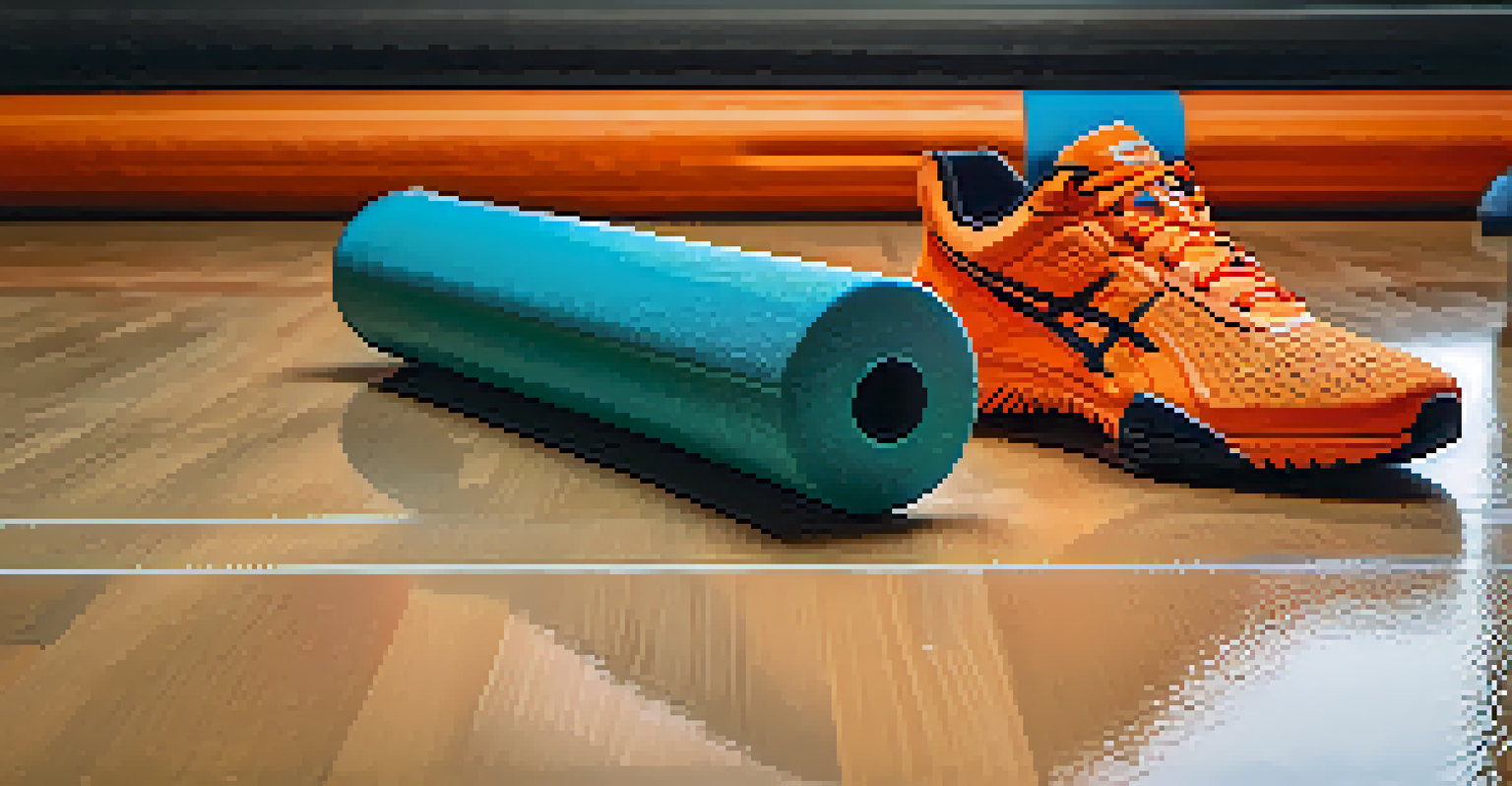Incorporating Foam Rolling for Recovery and Injury Prevention

Understanding Foam Rolling and Its Benefits
Foam rolling is a self-myofascial release technique that helps alleviate muscle soreness and improve flexibility. By applying pressure to specific areas of the body, foam rolling can enhance blood flow and accelerate recovery. This practice targets the fascia, a connective tissue that often becomes tight due to physical activity or stress.
The body achieves what the mind believes.
Engaging in foam rolling can also lead to significant improvements in your athletic performance. By loosening up tight muscles, you can achieve a greater range of motion, which is essential for executing movements effectively. Think of foam rolling as a way to fine-tune your body, similar to how a musician tunes their instrument before a performance.
Incorporating foam rolling into your routine can also be a fantastic preventive measure against injuries. Regularly addressing muscle tightness means you're less likely to strain or pull a muscle during workouts. Essentially, foam rolling helps you maintain your body's readiness for physical challenges.
When to Foam Roll for Maximum Effectiveness
Timing is crucial when it comes to foam rolling. Ideally, you should incorporate it both before and after your workouts for optimal benefits. Rolling before exercising helps warm up your muscles, making them more pliable and ready for action, while rolling afterward can aid in recovery by flushing out toxins and reducing soreness.

Think of pre-workout foam rolling as a warm-up routine, much like stretching. It prepares your muscles for the demands of your workout, reducing the risk of injury. Post-workout, it's akin to cooling down; it helps your body transition back to a resting state and promotes healing.
Foam Rolling Enhances Recovery
Incorporating foam rolling into your routine significantly improves blood circulation, reduces muscle soreness, and aids overall recovery.
Listening to your body is key; if you notice tight areas or knots, spend extra time on those spots. This targeted rolling can significantly enhance your flexibility and recovery, ensuring your muscles feel rejuvenated and ready for the next session.
Techniques for Effective Foam Rolling
There are several techniques to consider when foam rolling, each targeting different muscle groups. The most common method involves slowly rolling over the foam, pausing on tender spots to allow the muscle to relax. This technique is often referred to as 'rolling out' and can be likened to giving your muscles a gentle massage.
Take care of your body. It's the only place you have to live.
Another effective technique is the 'cross-friction' method, where you roll perpendicular to the muscle fibers. This approach can be particularly useful for areas like the IT band or calves, where tightness often occurs. Visualize this technique as a way to break up adhesions within the muscle, promoting better blood flow.
Lastly, don’t forget about your breathing. Inhale deeply as you roll over a tender spot, and exhale as you release the pressure. This simple practice not only enhances relaxation but also helps your body respond better to the foam rolling process.
Common Mistakes to Avoid When Foam Rolling
One common mistake many people make is rolling too quickly. While it might seem efficient, fast rolling can prevent you from truly benefiting from the massage. Instead, aim for a slow and controlled pace, allowing your muscles to respond appropriately to the pressure, similar to savoring a good meal.
Another pitfall is neglecting certain muscle groups. It's easy to focus on the more visible areas, like your quads and calves, but often overlooked muscles can also benefit from foam rolling. Make it a habit to target your upper back, hips, and shoulders, as these areas often hold tension that can lead to discomfort.
Timing Is Key for Foam Rolling
Utilizing foam rolling both before and after workouts optimizes muscle readiness and accelerates recovery.
Lastly, don’t foam roll over bony areas or joints. This can lead to discomfort or injury. Instead, focus on the fleshy parts of your body, ensuring you provide the right pressure where it’s needed most while avoiding sensitive areas.
How Foam Rolling Aids Recovery Post-Workout
Foam rolling plays a significant role in post-workout recovery by enhancing blood circulation. Improved blood flow means that your muscles receive essential nutrients and oxygen necessary for healing. Think of it as a delivery service for your muscles, bringing in all the good stuff they need to recover.
Additionally, foam rolling helps to reduce muscle soreness, often referred to as delayed onset muscle soreness (DOMS). By breaking down lactic acid buildup, foam rolling can minimize the discomfort you feel in the days following an intense workout. It’s like having a magic wand that alleviates the aches and pains that often accompany exercise.
Integrating foam rolling into your recovery routine can also improve your overall mobility and flexibility. As your muscles recover more efficiently, you’ll find it easier to perform daily tasks and engage in physical activities without feeling restricted. In essence, foam rolling is a key player in keeping you active and pain-free.
Foam Rolling and Injury Prevention: The Connection
Injuries often stem from muscle imbalances and tightness, making foam rolling a vital tool for prevention. By consistently addressing these issues, you can help keep your muscles balanced and functioning optimally. It’s akin to maintaining a car; regular check-ups can prevent major breakdowns down the road.
Foam rolling can also improve your body awareness, allowing you to identify tight spots before they turn into injuries. This self-awareness is crucial for athletes and fitness enthusiasts alike, as it helps you listen to your body’s signals. Just like a good coach, foam rolling can guide you to recognize when something feels off.
Avoid Common Foam Rolling Mistakes
To maximize benefits, focus on slow, controlled rolling and ensure you address all muscle groups while avoiding bony areas.
Incorporating foam rolling into your routine not only aids in recovery but also acts as a proactive approach to maintaining your overall physical health. By prioritizing injury prevention, you can enjoy your workouts more and focus on achieving your fitness goals without unnecessary interruptions.
Creating a Foam Rolling Routine for Yourself
Developing a foam rolling routine tailored to your needs is a great way to enhance its benefits. Start by identifying your problem areas; this could be muscles that often feel tight or sore after workouts. Creating a personalized routine is similar to crafting a recipe; knowing your ingredients allows you to adjust according to your taste.
Consider setting aside a few minutes each day for foam rolling, whether it’s in the morning, before a workout, or in the evening. Consistency is key, as regular practice will yield the best results over time. Just like forming a habit, the more you roll, the more natural it will become.

Lastly, don’t hesitate to mix things up! Experiment with different techniques and focus on various muscle groups to keep your routine fresh and engaging. This adaptability not only keeps your sessions interesting but also ensures that you address all areas of your body effectively.